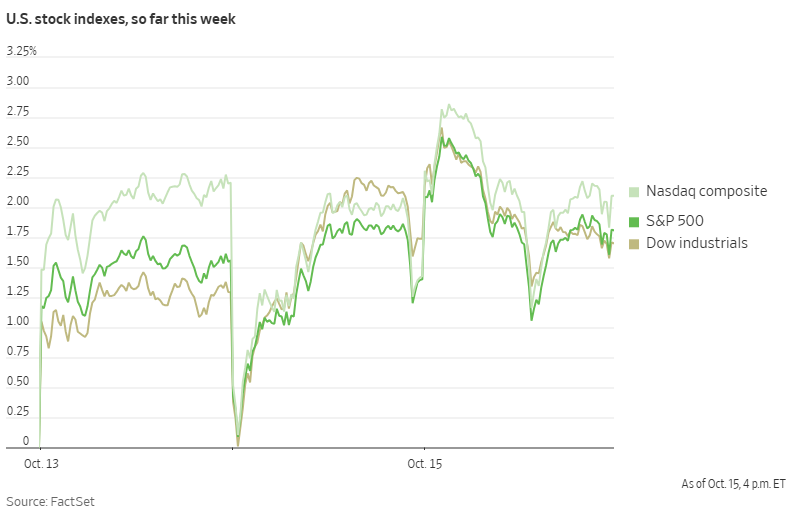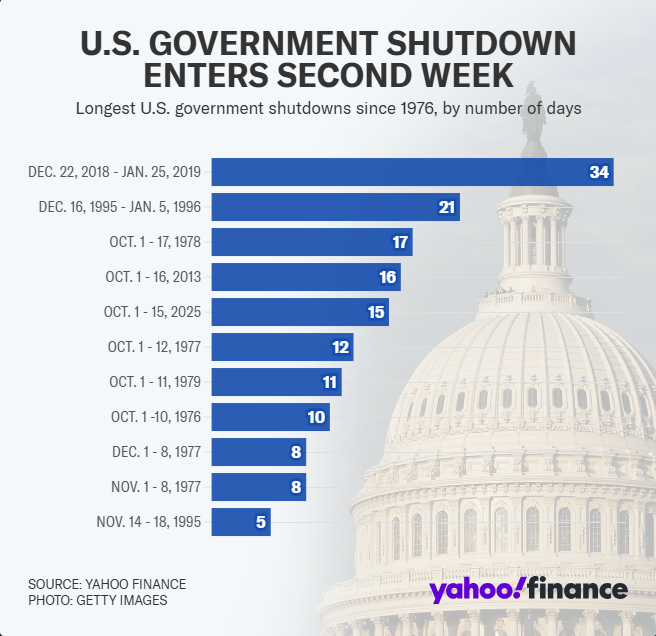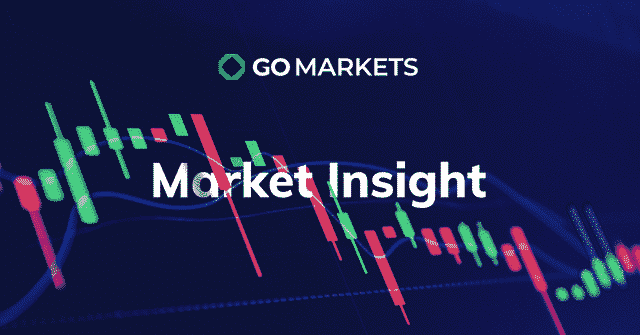Notícias de mercado & insights
Mantenha-se à frente dos mercados com insights de especialistas, notícias e análise técnica para orientar suas decisões de negociação.

S&P 500 and ASX Rally as Big Banks Drive Markets
Both the S&P 500 and ASX have rallied on the back of stronger-than-expected major bank earnings reports on both sides of the Pacific.
In the US, Bank of America reported a 31% year-over-year increase in earnings per share at $1.06, exceeding Wall Street's estimate of $0.95. Meanwhile, Morgan Stanley delivered a record-breaking quarter with EPS of $2.80, a nearly 49% increase from the same period last year.

On the Australian front, the benchmark ASX 200 leapt 1.03% to 8990.99, with all four major Australian banks playing a major role. CBA closed 1.45% higher, Westpac 1.98%, NAB 1.87%, and ANZ 0.53%.
These strong bank results indicate broader economic strength, despite recent concerns about US-China trade tensions. US Treasury Secretary Scott Bessent emphasised that Washington did not want to escalate trade conflict with China and noted that President Trump is ready to meet Chinese President Xi Jinping in South Korea later this month.
With the third-quarter earnings season just getting underway, these early positive results from financial institutions could prove as the start of continued market strength through to the end of the year.
U.S. Government Shutdown Likely to Last Into November
Washington remains gridlocked as the U.S. enters its 16th day of shutdown. With no signs of compromise on the horizon, it appears increasingly likely the shutdown will extend into November and could even compromise the Thanksgiving holiday season.
Treasury Secretary Scott Bessent has warned "we are starting to cut into muscle here" and estimated "the shutdown may start costing the US economy up to $15 billion a day."
The core issue driving the shutdown is healthcare policy, specifically the expiring Affordable Care Act subsidies. Democrats are demanding these subsidies be extended, while Republicans argue this issue can be addressed separately from government funding.
The Trump administration has taken steps to blunt some of the shutdown's immediate impact, including reallocating funds to pay active-duty soldiers this week and infusing $300 million into food aid programs.
However, House Speaker Mike Johnson has emphasised these are merely "temporary fixes" that likely cannot be repeated at the end of October when the next round of military paychecks is scheduled.

By the end of this week, this shutdown will become the third-longest in U.S. history. If it continues into November 4th, it will surpass the 34-day shutdown of 2018-2019 to become the longest government shutdown ever recorded.
This prolonged shutdown adds another layer of volatility to markets. While previous shutdowns have typically had limited long-term market impacts, the unprecedented length and timing of this closure, combined with its expanding economic toll, warrant closer attention as we move toward November.
Trump Announces Modi Has Agreed to Stop Buying Russian Oil
Yesterday, Trump announced that Indian Prime Minister Narendra Modi has agreed to stop purchasing Russian oil. He stated that Modi assured him India would halt Russian oil imports "within a short period of time," describing it as "a big step" in efforts to isolate Moscow economically.
The announcement comes after months of trade tensions between the US and India. In August, Trump imposed 50% tariffs on Indian exports to the US, doubling previous rates and specifically citing India's Russian oil purchases as a driving factor.

India has been one of Russia's top oil customers alongside China in recent years. Both countries have taken advantage of discounted Russian oil prices since the start of the Ukraine invasion.
Analysis suggests India saved between $2.5 billion to $12.6 billion since 2022 by purchasing discounted Russian crude compared to other sources, helping support its growing economy of 1.4 billion people.
Trump suggested that India's move would help accelerate the end of the Ukraine war, stating: "If India doesn't buy oil, it makes it much easier." He also mentioned his intention to convince China to follow suit: "Now I've got to get China to do the same thing."
The Indian embassy in Washington has not yet confirmed Modi's commitment. Markets will be closely watching for official statements from India and monitoring oil trading patterns in the coming weeks to assess the potential impact on global energy flows and prices.
Chart of the Day - Gold futures CFD (XAUUSD)


What is going on with Taiwan? Taiwan is back in the news after US speaker of the house Nancy Pelosi visited the country causing a fiery reaction from the mainland of China. Historical background In order to understand the causes of the China/Taiwan tension, some historical perspective is needed.
The current tension stems from the Chinese civil war 1927 – 1949 where Mao Zedong’s Communist army and Chiang Kai- Shek’s Republic of China army fought in a series of intermittent battles to secure control of mainland China. As the Communist army began to gain ascendancy, Chiang Kai–Shek and the Republic of China movement was forced into exile to Taiwan. Since this exile and lasting until today, a long-standing military and political standoff has been in place between the two countries with each claiming to be the rightful controller of China.
In recent years, China has attempted to expand its influence and places such as Hong Kong have seen Beijing challenge its sovereignty the pressure has been building on Taiwan. At times of increased tension, China has conducted military exercises in the Taiwan Strait to act as a ‘warning’ to Taiwan and the West that it may be treading too close to China’s political interests. Current Day Events Nancy Pelosi became the first US speaker of the House to visit Taiwan in more than 25 years.
The visit by Pelosi, whilst not necessarily threatening is an act that supports the legitimacy of Taiwan as a democratic, sovereign government. Pelosi challenged the essence of China’s communist regime and stated, “Today the world faces a choice between democracy and autocracy.” However, the speaker did not go as far as to offer any specific military support to protect against an aggressive response from the CCP.. Any act of economic or military support has the potential to draw an aggressive response from the CCP.
Why does this matter? Traders and investors do not have to look too far to see what can happen to the market if geopolitical conflict breaks out. It is still only a few months on since the Russia and Ukraine conflict broke out.
After the initial invasions, commodity prices soared as sanctions were placed on Russia and supply chains were placed under pressure. The market is still trying to adjust to these consequences today. In addition, the Ruble took a huge hit and Moscow Exchange had to be closed as countries placed sanctions on Russia and its monetary system.
If China was to invade Taiwan it is reasonable to expect economic sanctions will follow. With China being such a huge player in the global supply chain, it may have a larger effect on commodity prices. The Ukraine conflict showed the world how fragile global supply chains can be when conflict strikes.
Specifically, Gas, Grain, Oil rocketed in price. Regarding Taiwan and China, a large portion of the world semi- conductors are produced in Taiwan which means that there could be disastrous consequences that may ensure should war breakout. A more detailed discussion on the impact that a shortage of semiconductors may have can be found below. https://www.gomarkets.com/au/articles/economic-updates/semi-conductor-supply-crunch/ Similarly, the Yuan may take a hit with any kind of escalation in conflict.
Therefore, traders should be aware of the conflict and ongoing tensions as trading opportunities may eventuate. The USDCNH can be traded on Go Markets platforms.


The Society for Worldwide Interbank Financial Telecommunication, legally S.W.I.F.T. SC, is a Belgian cooperative society providing services related to the execution of financial transactions and payments between banks worldwide. Its principal function is to serve as the main messaging network through which international payments are initiated.
It also sells software and services to financial institutions, mostly for use on its proprietary "SWIFTNet". Its important to understand that money is not moved through the SWIFT system but most importantly is the data attributed to the money that is moved through this medium. In other words, without SWIFT the institutions wouldn’t know who and for what reason is a transaction is being made.
For example; if you are sending money from country to country, SWIFT would inform the recipient bank that is getting the money, to expect a certain sum, from a certain bank. So its an extremely important step that will be taken away from Russia. If you do not have that information flow; you simply cannot do any international transactions.
SWIFT welcomes the public launch of the New Payments Platform (NPP) in Australia, which is set to revolutionise the way payments are made domestically. SWIFT has helped to design, build, test and deliver the NPP and will play a key role in operating the infrastructure for the NPP. The NPP’s paradigm-shifting financial architecture has been designed and constructed to fundamentally improve how consumers, businesses and governments transact with one another.
The key features of the NPP include: 24/7 instant payments and real-time line-by-line settlement via the Reserve Bank of Australia’s Fast Settlement Service PayID, the new and easy way to link a financial account with an easy-to-remember identifier such as a mobile phone number, email address or ABN for businesses Open access platform that truly empowers innovation through competition Overlay services framework that will provide new value services to Australian consumers, businesses and government Russia’s SWIFT Sanction Since the invasion of Russia, many countries have joined forces in order to impose heavy sanctions on Russia. Some of these actions are to limit, deter and coerce Russia or Vladimir Putin into changing his strong stance in the war against Ukraine. These sanctions would be felt throughout all classes of Russia’s community and its corporate arm.
One popular sanction has been to remove Russia from the SWIFT messaging system, with the intention to stop any Russian companies from doing international business, which in turn would hurt Russia’s economy and potentially turn Russian loyalists against Mr. Putin and force him into an unlikely reversal of the war. Although this is somewhat looked upon as a key destabilizing strategy by the West, there are some that feel the move is mostly symbolic.
EU bars 7 Russian banks from SWIFT, but spares those in Energy (Reuters). The European Union said on Wednesday (2 nd march) it was excluding seven Russian banks from the SWIFT messaging system, but stopped short of including those handling energy payments, in the latest sanctions imposed on Russia over its invasion of Ukraine. VTB Bank PJSC and Bank Rossiya are among the banks that face a ban from the messaging system.
The other institutions included on the EU list are Bank Otkritie, Novikombank, Promsvyazbank PJSC, Sovcombank PJSC and VEB.RF, said the officials, who asked not to be identified because the decision was private. European Union ambassadors agreed to spared the nation’s biggest lender Sberbank PJSC and a bank part-owned by Russian gas giant Gazprom PJSC. Would it work: Professor of Financial Economics at the University of Loughborough University, Alistair Milne, explains why he is sceptical of the sanction. “Russia’s exclusion from the international payments messaging system Swift, is presented as a powerful means of undermining its economy.
But for a payment’s expert such as myself, this is something of a myth.” He continues, “The reality, however, is that limiting access to Swift is less practically effective than most media coverage supposes. It is an important symbol of global repudiation of Russia’s exercise of military force, but not much more. It is other measures, such as blocking the central bank of the Russian Federation from transacting internationally, which is undermining confidence in the Rouble.” “There is no fundamental problem with transferring funds using some other secure messaging systems.
Russian banks might, for example, instead arrange payments using the SPFS system, which was established after the 2014 invasion of Crimea by the Russian central bank. This is currently used by a handful of international banks in Germany and Switzerland linked to Russian banks.” “Or they could use the CIPS network, which was created by the People’s Bank of China for the purpose of cross-border payments with indirect participants in many countries. They could even use WhatsApp to instruct the necessary transactions.” Leaving room for negotiation?
The EU has avoided the sanctioning of all Russia banks, specially those that use SWIFT in the energy industry. This might be crucial as they seem to be trying to limit Russia, but at the same time keep the door ajar to be able to negotitate energy deals, which, the West are hugely dependednt on. Another thing to note is payments for Russian energy exports, for example to Gazprom, are even less Swift-dependent.
When operators buy oil or gas from Gazprom, they make payments in either euro or US dollars into bank accounts held by the Russian energy company. So if the intention of sanctions is to block payments for Russian gas, the tool is not Swift; it is sanctions on Gazprom and its banking facilities. Perhaps this could be something that is visited in the future.
The absence of Sberbank PJSC and Gazprombank shows the continuing level of concern over the consequences for Europe from a financial isolation of Russia spilling over into the global economy, especially when it comes to energy supplies. The bloc is also worried Russia could retaliate by cutting deliveries. Sources: Reuters, Wikipedia, Loughborugh University, Bloomberg, swift.com


Walmart tops expectations for Q2 – the stock is up Walmart Inc. (WMT) announced its Q2 financial results before the market open on Wall Street on Tuesday. World’s largest supermarket chain reported results that exceeded analyst expectations, sending the stock price higher. The company reported revenue of $152.859 billion (up by 8.4% year-over-year) vs. $150.994 billion expected.
Earnings per share reported at $1.77 per share for the quarter vs. $1.62 per share estimate. Doug McMillon, President and CEO of Walmart commented on the latest results: ''We’re pleased to see more customers choosing Walmart during this inflationary period, and we’re working hard to support them as they prioritize their spending. The actions we’ve taken to improve inventory levels in the U.S., along with a heavier mix of sales in grocery put pressure on profit margin for Q2 and our outlook for the year.
We made good progress throughout the quarter operationally to improve costs in our supply chain, and that work is ongoing. We continue to build on our strategy to expand our digital businesses, including the continued strength we see in our international markets.'' Walmart Inc. (WMT) chart The stock was up by over 6% on Tuesday, trading at $140.233 a share. Here is how the stock has performed in the past year: 1 Month +8.62% 3 Month +7.14% Year-to-date -2.74% 1 Year -6.62% Walmart price targets Deutsche Bank $142 Raymond James $140 BMO Capital $160 Cowen & Co. $150 Morgan Stanley $145 UBS $152 Credit Suisse $133 Wells Fargo $130 Walmart is the 14 th largest company in the world with a market cap of $383.98 billion.
You can trade Walmart Inc. (WMT) and many other stocks from the NYSE, NASDAQ, HKEX and the ASX with GO Markets as a Share CFD. Sources: Walmart Inc., TradingView, MetaTrader 5, Benzinga, CompaniesMarketCap


The USDJPY has been in an extremely strong upward trend since September 2021. This pair's recent price action has also been charactarised by relatively weak retracements as it has trended higher. Inflationary pressures have acted as a strong catalyst for the USD against most other currencies further aided by the Federal Reserve taking a strong stance against inflation with a series of aggressive interest rate hikes.
At the same time, the JPY has remained weak as the Central Bank of Japan has refused to intervene and shift from its dovish stance. The most recent retracement shows the potential for a good risk/reward Long trade. On the chart, it can be seen that the price has pulled back to the 23.60% Fibonacci level, which is at 132/133JPY.
This area also doubles as a support zone with the prior resistance level becoming a level of support which is another sign that the trend may continue. On the weekly chart, the characteristics of the candlesticks near the support zone also support the premise that the price may bounce. The candles have long wicks touching the support area indicating that the buyers are soaking up the supply.
They have also closed near their opening price again showing how buyers are soaking up the supply. The 4-hour chart shows a consolidation of the price forming a triangle, with the potential to break out to the upside. This may provide an alternative entry signal for the same overall strategy.
An important aspect to remember when trading this strategy is to ensure that price occurs with relatively high volume. Large volume indicates that buyers are regaining control over the price, and that sellers have become exhausted. Potential risks There are some risks with this trade.
Firstly, the pair is already quite overextended with the price at multi-decade highs. In addition, with US inflation fears potentially easing and interest rate hikes priced in already, the current price may be near its peak.


USDJPY ready to bounce or retrace further. The USDJPY has been recently provided great buying opportunities for traders. However, in recent days it has posted its largest drop since beginning the current upward at the beginning of January 2021.
The question remains, is this just a standard retracement or is it a symbol of a much bigger reversal. In the last few months, the USD has risen sharply as the market has responded to inflation fears and geopolitical events. With inflation levels at record levels across much of the developed world many Central Banks have shifted to a hawkish stance regarding their monetary policy with the USA being a prime example of this.
On the contrary, the Central Bank of Japan has remained dovish almost acting as a lone solider compared to other countries in this regard. Despite this, as bond yields have begun to settle down and the market has begun to price in recession fears and inflation, the YEN has become attractive again. Technical Analysis Looking at the technical elements of the chart, the price is down from the multi decade highs of 139 that it reached in the middle of July.
Importantly the price has also dropped below the most recent support level. In addition, the price has also breached the 50-day moving average. The question that remains is whether this is a simple retracement or the signs of a reversal occurring.
There are two characteristics of this price action that support the potential bounce back to the upside for this currency pair. Firstly, on the daily, chart, although the price did break through the initial first level of support it is currently holding the next stronger level down at 131/132. In addition, looking at the weekly chart, the price is showing a relatively strong bounce off the same 131/132 zone.
This multi timeframe analysis, further supports the continuation of the upward trend of the pair. The midterm buy target may be a retest of the 140 level. There is a large risk with this trade.
If the ‘Top’ is indeed ‘in’ and the pair does start to falter, then there is risk of massive selling. This is because the pair is already so overextended to the buy side. In addition, a rush to close Yen short positions may further accelerate the move back downward.
If this does occur and the 130 level breaks it may see the price fall to the 125 level. The short-term future of the pair will still likely be determined by short term economic news and activity within both Japan and the USA.


US economic data revealed last night shows that the country’s GDP has shrunk by 0.9%, although some are remaining positive that a recession may still be avoided. Despite the worrying figures, Federal Reserve Chair, Jerome Powell, outlined his belief that due to low unemployment figures of 3.6% and a strong market for jobs with 11 million job openings that there may be a 'soft landing'. Joe Biden commented, “It’s no surprise that the economy is slowing down as the Federal Reserve acts to bring down inflation.” More US CPI data is expected to be announced tonight.
In response to the GDP figure, the US indices had another green day with the Dow Jones, the Nasdaq, and the S&P500 all rising 1.03%, 1.08%, and 1.21% respectively. In terms of share price movement, Meta’s stock price dipped 5.22% as it posted its first-ever quarterly drop in revenue, signaling how interest rate hikes have been impacting growth companies. The data also followed through to the Australian market with the yield on 3-year government bonds falling to 3.1%.
The ASX200 also continued its momentum for the week as it pushed higher again on Thursday. Brent Crude Oil had a mixed day ending the day flat at $107.58. Gold continued to bounce off its support zone and climbed up 1.25% and Natural Gas fell 4.66% as it continues to pull back from its recent highs dropping 4.66%.
FOREX and Cryptocurrency The USD dropped sharply as the GDP figures were announced. It recovered briefly, before selling back down, closing towards the lowest price of the day, a total drop of 0.28%. Bitcoin and Ethereum also gained momentum as money continued to flow back into risk assets, with the latter jumping to its highest level since the middle of July.
ETHUSD closed at $1726 and Bitcoin at $23,860.

